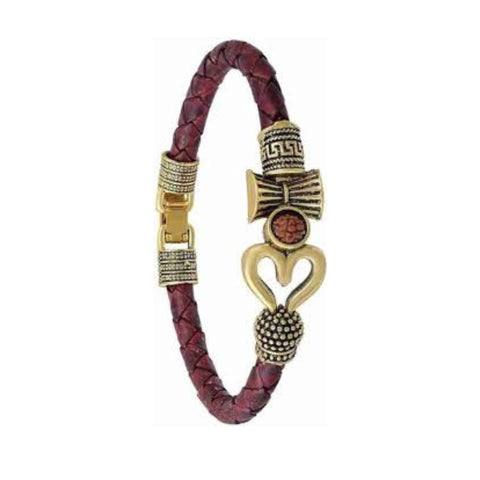The Trishul Damroo Kada, a unique bracelet adorned with the powerful symbols of the Trishul (trident) and Damroo (hand drum), holds a significant place in both Hindu tradition and modern fashion. This article delves into the multifaceted appeal of this captivating bracelet, exploring its historical origins, spiritual significance, potential benefits, and its popularity in contemporary times.
A Brief History Of Trishul Damroo Kada:

The origins of the Trishul Damroo Kada remain shrouded in the mists of time, intertwined with the rich history of Hinduism. The Trishul, a three-pronged trident, is a potent symbol associated with Lord Shiva, the destroyer and regenerator within the Hindu trinity. It represents his power, his ability to overcome negativity, and his role in maintaining the cosmic balance. The Damroo, a hand drum shaped like an hourglass, is also closely linked to Lord Shiva and symbolizes his cosmic dance, the eternal rhythm of creation and destruction.
While the exact history of the Trishul Damroo Kada is unclear, it is believed to have emerged as a way for devotees to carry these powerful symbols with them throughout the day. Traditionally, these bracelets were crafted from various materials like wood, metal, or rudraksha beads, often worn by sadhus (holy men) and yogis as a symbol of their devotion and spiritual path.
Spiritual Significance and Potential Benefits:
Devotees wear the Trishul Damroo Kada for various reasons, both spiritual and symbolic:
- Devotion to Lord Shiva: Primarily, the bracelet serves as a potent symbol of devotion to Lord Shiva. Wearing it is a way for devotees to express their faith, connect with his divine essence, and seek his blessings.
- Spiritual Growth and Protection: The combination of the Trishul and Damroo is believed to offer spiritual protection from negativity and negative energies. Many believe it promotes spiritual growth, enhances focus during meditation, and fosters a sense of inner peace and well-being.
- Harmony and Balance: The Trishul, symbolizing Lord Shiva's destructive aspect, is believed to balance the creative energy represented by the Damroo. This resonates with the concept of maintaining balance in various aspects of life, both internal and external.
- Auspiciousness and Good Fortune: In some traditions, the Trishul Damroo Kada is considered an auspicious symbol, attracting positive energy and good fortune. While the scientific validity of these benefits remains inconclusive, they hold significant meaning within the context of faith and cultural beliefs.
Why Do People Wear It Today?
The appeal of the Trishul Damroo Kada has transcended its religious roots, finding resonance with individuals from diverse backgrounds:
- Cultural Connection: The bracelet serves as a cultural symbol, connecting the wearer to their Hindu heritage and traditions. It allows individuals to express their cultural identity and connect with their spiritual roots.
- Fashion Statement: The unique design and symbolism of the bracelet make it a visually striking piece of jewelry. Individuals appreciate its aesthetic appeal and may choose to wear it as a fashion statement, regardless of their religious beliefs.
- Personal Connection: Some individuals find personal meaning in the symbolism of the Trishul and Damroo, drawing a connection to the concepts of strength, resilience, and the cyclical nature of life.
- Sense of Well-being: Beyond any religious significance, some wear the bracelet for a perceived sense of calm and well-being associated with the symbols and their connection to Lord Shiva.
Modern Adaptations and Considerations:
The modern iteration of the Trishul Damroo Kada often incorporates leather in its design. While traditional materials like wood or metal still hold significance, leather offers a versatile and comfortable option for everyday wear. However, it is crucial to ensure the leather is ethically sourced and avoids contributing to animal cruelty.
Additionally, it is essential to respect the cultural and religious significance of the symbols when wearing the Trishul Damroo Kada. It is recommended to approach it with respect and avoid using it solely as a fashion accessory without understanding its deeper meaning and potential cultural sensitivity.